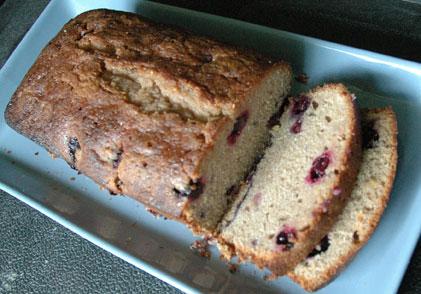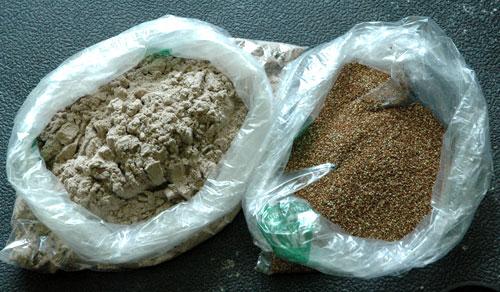Teff – A Nutritious and Versatile Grain
Here is a recipe for a Blueberry Lemon Bread that I made using a combination of wheat and Teff flour. Not exactly low fat or low sugar, but a nice treat with a bit of a nutrition boost from the addition of Teff flour. I have only been able to find dark Teff flour so that is what I used in this blueberry lemon bread and the loaf was moist and delicious.

- 1/2 cup softened butter
- 1 cup granulated sugar
- 2 eggs
- 1 cup all-purpose flour
- 1/2 cup Teff flour
- 1/3 teaspoon salt
- 1 teaspoon baking powder
- Zest (rind) of one lemon, grated
- 1/2 cup milk
- 1 cup blueberries (fresh or frozen)
-
Preheat oven to 350. Lightly grease one (1) loaf pan.
-
In a large bowl, cream butter and then add sugar, a little bit at a time. Beat in the eggs.
-
In another bowl, combine and sift together the all-purpose flour, Teff flour, salt, and baking powder. Mix in the grated lemon rind (zest). Add the flour mixture alternately with milk to the butter mixture. Gently fold in the blueberries.
-
Pour batter into prepared loaf pan and bake 55 to 60 minutes or until a toothpick inserted in the center comes out clean. A good check is to use an instant digital thermometer to test your bread. The internal temperature of the bread should be at 200 degrees F.
-
Remove from oven and allow to cool for a few minutes; then remove from pan.
-
In a small bowl, combine sugar and lemon juice for the topping. Spoon the sugar mixture over the warm loaf.
 I get many readers asking what cooking/meat thermometer that I prefer and use in my cooking and baking. I, personally, use the Thermapen Thermometer. Originally designed for professional use, the Super-Fast Thermapen Thermometer is used by chefs all over the world. I only endorse a few products, on my web site, that I like and use regularly.
I get many readers asking what cooking/meat thermometer that I prefer and use in my cooking and baking. I, personally, use the Thermapen Thermometer. Originally designed for professional use, the Super-Fast Thermapen Thermometer is used by chefs all over the world. I only endorse a few products, on my web site, that I like and use regularly.
You can learn more or buy yours at: Super-Fast Thermapen Thermometer.
Sponsored Content
What is Teff?
Teff is an ancient and intriguing grain, tiny in size yet packed with nutrition. It is simple to prepare and similar to millet or quinoa in cooking. Teff is a great addition to your diet for nutrition, taste, and variety.
Teff is native to Ethiopia where it accounts for one quarter of the total cereal production. Not a newcomer, it is believed that teff originated in Ethiopia between 4000 BC and 1000 BC. Although it has been used in Northeast Africa for centuries, teff only became known in other parts of the world in the late 20th century when farmers began to cultivate it in Australia and the Central United States.A growing demand for teff has made it more readily available in North America. It can usually be found in health food stores either in the grain form or ground into flour.
There are a few different varieties of teff that vary in color from light to dark. White teff has a chestnut-like flavor while darker varieties are more earthy in flavor with a slight hazelnut taste. Historically, white teff has been the most popular (and least widely available) variety. Perhaps due to its relative scarcity, historically white teff was regarded as a status symbol. More common is red teff. Red teff is higher in iron and has been rising in popularity in recent years.
Health Benefits of Teff:
Teff is packed with nutrition. It is higher in protein than wheat and has a high concentration of a wide variety of nutrients, including calcium, thiamin and iron. The iron from teff is easily absorbed by the body.
Since the grains are so small, the bulk of the grain is germ and brand. It is very high in fiber and is thought to benefit people with diabetes as it helps control blood sugar levels. Teff contains no gluten which makes it a suitable grain for celiacs or people with wheat sensitivities. Due to its nutritional content and energy enhancing properties, it has also gained favor with athletes.
A cup of cooked teff contains 387 mg of calcium which is 40% of the U.S. recommended daily allowance (USRDA). Teff has twice as much iron as both wheat and barley.
How Is Teff Flour and Grain Used?
Teff Flour: The teff grain is ground into flour and can be used as a substitute in most baking for all or part of the wheat flour. Teff would not work well on its own in baking that depends on gluten for its structure (such as yeast-risen bread).
In Ethiopia, teff is fermented and used to make injera, a traditional sourdough-type flatbread.
How to cook with Teff Flour: The properties are somewhat different than wheat flour (no gluten) so start off start off by substituting about 25% of the wheat flour in a recipe with teff flour.
Teff Grain: Uncooked teff grains can be used in cooking and baking in place of other types of small grains, nuts or seeds. Because of its small size, make sure to use a smaller amount of teff when substituting. For example, use 1/2 cup of teff grain for 1 cup of sesame seeds.
Teff can also be used as a thickener in soups, gravies and stews. Teff is often cooked as a porridge and when cooked, its stickiness allows it to easily be formed into cakes (polenta-like).
How to cook with Teff Grains: Place 1/2 cup teff grains, 2 cups water, and 1/4 teaspoon of salt in a saucepan. Bring to a boil, reduce the heat and simmer for about 15-20 minutes or until water is absorbed. Remove it from the heat and let it stand for about five minutes. Season with butter, salt and herbs or a sweetener such as maple syrup.
Teff Trivia:
- Teff is one of the smallest grains in the world. It measures 1/32 of an inch in diameter.
- The name, “teff” is derived from the *Amharic “teffa” which translates as lost. Due to its tiny size, teff can easily be lost if dropped!
- 150 teff grains are equal in size to one kernel of wheat.
- Teff is also called lovegrass or bunchgrass. Eragrostis tef (one variety of teff) is derived from the Greek eros (love) and grostis (grass).
- In Ethiopia, teff is grown as forage for cattle and also used in adobe construction.
- Teff is used to make home brewed alcohol.
- 1 pound of teff can produce up to 1 ton of grain in as little as 12 weeks.
- 3000 grains of teff weighs only 1 gram.
 Charlotte Bradley is the publisher of YogaFlavoredLife.com and an avid yoga practitioner. She was a student of karate for many years and took up yoga only tentatively after the birth of her sons and a knee injury left her looking for a less high-impact form of exercise. It was love at first pose as Charlotte saw how quickly yoga sped her rehabilitation along. She also found that yogic relaxation techniques lent her proper focus, bringing balance into her life as well as a greater appreciation for how blessed she truly is.
Charlotte Bradley is the publisher of YogaFlavoredLife.com and an avid yoga practitioner. She was a student of karate for many years and took up yoga only tentatively after the birth of her sons and a knee injury left her looking for a less high-impact form of exercise. It was love at first pose as Charlotte saw how quickly yoga sped her rehabilitation along. She also found that yogic relaxation techniques lent her proper focus, bringing balance into her life as well as a greater appreciation for how blessed she truly is.
Check out all of Charlotte Bradley’s Healthy Lifestyles columns.

